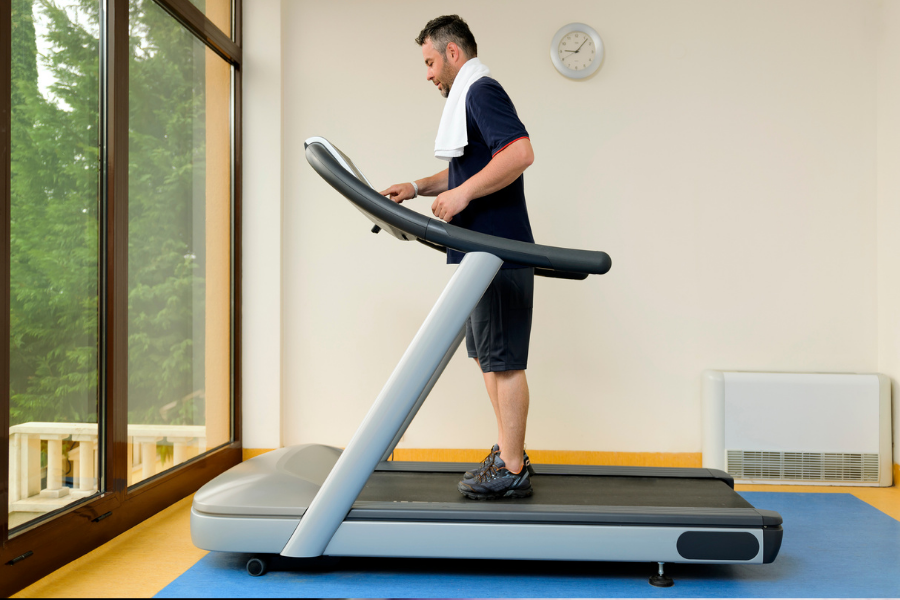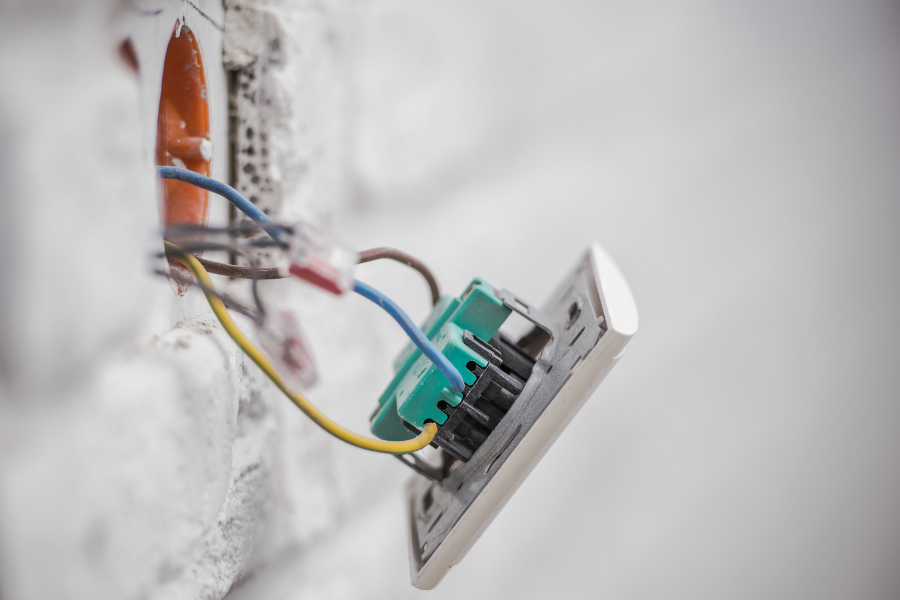Static Shocks and Athletic Mats
Static electricity can build up and can be quite annoying for those operating high-tech electrical equipment. This can even become a problem for those who own an operate a gym, as gym goers may receive an electric shock from a static charge. It’s not only bothersome, but static electricity can also wreak havoc on your expensive exercise equipment, leading to costly repairs. The last thing that you want is to have to purchase replacements for your fried equipment. In this article, we’re going to examine what static electricity is, what are the best mats to protect against static shocks, and 5 tricks to limit static electricity in the gym.
What is static electricity?

Without delving too much into the technical side of things, static electricity is the buildup of a static charge caused by the friction of two objects rubbing on one another. When you rub two objects together, one object will give up electrons to the other object, in turn becoming more positively charged, whilst the other object that collects the neutrons will become more negatively charged. This flow of electrons causes a static discharge which gives you a mild shock.
The human body is an electrical conductor. Electricity can easily pass through our bodies, which makes it that much more dangerous to us.
You may be familiar with this when you walk on a carpet, slowly drag your feet, and go to touch someone. You’ll transfer a static discharge to another person. Static electricity is more likely to occur in rooms with cool, dry air, as the air is less conductive and this increases the effect. If you work out in and non-insulated, unheated garage, then you may experience static electricity in winter.
Static electricity, in the most extreme circumstances, can cause major damage, including fires and personal injury. For instance, when working around combustible materials, static electricity can be very dangerous and can cause an explosion.
How is electrical resistance measured in mats?
In order to learn how conductive mats are, each mat is checked for electrostatic discharge. Since humidity factors into the tests, mats are usually checked at 50% and 12% humidity to find a median level of conductivity. Electrical resistance is measured in ohms, and ohms is such a high number that it’s written as a power of 10:
- Electrically conductive mats: Between 10 to the power of 1 and 10 to the power of 5 ohms
- Static dissipative mats: Between 10 to the power of 6 and 10 to the power of 9 ohms
- Anti static mats: Between 10 to the power of 10 to the power of 10 and 10 to the power of 12
It should be noted that there is no such thing as a truly anti static mat, that all materials can still carry a certain level of charge. It’s only that at such high resistance, you cannot really generate a static electrical shock.
The best types of mats that limit static electricity

When you’re looking to purchase a mat that will reduce static shocks, there are several different materials for you to choose from. The three most common types of antistatic mats are PVC, rubber, or ESD. They have their own benefits and drawbacks, so let’s examine each to figure out what’s best for you if you want to avoid static shock.
Rubber mats
Ohm resistance: Between 10 to the power of 1 to 10 to the power of 4
Rubber mats feature high electrical resistance, making them the ideal anti static mats. Rubber is the go to for workers looking to protect themselves from electrical shocks, and it is a great insulator protecting against both cold temperatures and static charges. It is also great to use as anti fatigue mats as it provides just enough cushioning, whilst also providing grip to stand on.
Rubber mats are great to place underneath machines, as they can handle the burden of heavy weights. Placing rubber mats between your equipment and a concrete floor will also allow you to prevent against damage to both the machine and the flooring underneath.
Check out these great rubber mats from British Martial Arts Mats:
- RUBBER BLUE FLECK GYM MATS WEIGHT TRAINING 1M X 1M X 20MM
- RUBBER BLUE FLECK GYM JIGSAW MATS WEIGHT TRAINING 1M X 1M X 10MM
PVC or Vinyl mats
Ohm Resistance: Between 10 to the power of 4 and 10 to the power of 5
Another anti static mat, PVC mats feature an outer coating which can prevent against friction and is less likely to generate static charges. Mats that are made with a vinyl outer coating are usually much better at providing grip, allowing athletes to gain an upper hand on their opponent. At British Martial Arts Mats, our judo mats are PU foam mats wrapped in a vinyl outer coating.
Electrostatic dissipative mats (ESD)
Ohm Resistance: Between 10 to the power of 6 and 10 to the power of 9
Static dissipative mats are mats that are specifically designed to protect sensitive equipment, allowing them to function properly. For example, if you are a manufacturer of computer microchips, it may be beneficial for you to have ESD mats set up to help dissipate the static electricity caused by people shuffling about through the workplace. ESD mats may be overkill for the average customer, as most people aren’t dealing with sensitive machinery and will probably not notice a difference between ESD mats and rubber mats.
Five ways to stop static shocks
Below, you’ll find five tips to help you avoid causing static buildup from your treadmill, elliptical machine, or another piece of fitness equipment. These tips can safeguard your home and gym, allowing you to use the equipment in your home without risk of a static shock.
-
Place a mat underneath your treadmill

The first place to start when you’re looking to prevent static charges is to place mats underneath your athletic equipment in order to insulate against electricity and prevent friction. As discussed above, rubber mats are great to place underneath of athletic equipment. Rubber mats are also great to use as workout mats, especially when using heavy weights.
Besides preventing static shocks, by placing a mat underneath your treadmill can help prevent the buildup of dust, debris, and dirt in your treadmill’s motor. Static electricity acts as a vacuum, pulling dirt and dust towards the motor.
-
Wear the right clothing for exercise
Your clothing has the potential to create static buildups in your skin. Some workout clothes are great to use for exercise, like strength work. Most athletic clothing is engineered to wick moisture away from the body, and they’re usually made from synthetic materials. Synthetic materials can cause a buildup of static electricity. However, clothing made from natural fibers like wool, bamboo, or cotton are less likely to build up a static electric charge, making it the most ideal form of athletic clothing for someone conscious of static problems.
-
Add moisture with a humidifier

One issue you may encounter is that static electricity is more likely to buildup in dry environments. This is especially true during winter seasons when the air has less moisture in it. By purchasing a humidifier for your home gym, you can mitigate some of the harmful effects of static shock.
Set the humidity level to between 40-50%, and this can greatly reduce the chances of electric shock. Having a humidifier in your home gym can also prevent skin irritation caused by dry air, which is likely to occur during the winter. Having the proper air humidity can actually help your health as well.
-
Connect your equipment to a grounded electrical outlet

Another important consideration is to make sure that all of your athletic equipment is plugged into a grounded electrical outlet. A grounded outlet works as a buffer and uses a ground wire to dissipate electrical surges which can damage machines and cause injury. It might be best to check with a local electrician to make sure that all of your electrical outlets are in proper working order.
Also, make sure that your treadmill is rated for a 230 V UK/European circuit. In North America they use 120 V circuits, whereas in the UK, we used 230 V circuits. If you bought a piece of machinery that is being shipped to you from overseas, make sure that it is compatible with UK electrical outlets.
-
Use anti static spray
Another option available for you is to use anti static spray for your clothing to prevent buildups of static charges. Some sprays are used to prevent against static cling on clothes, and may be helpful to use in the gym if you’re worried about static charges.
Conclusion
Electricity is a dangerous, yet helpful, commodity that we use to power homes. Human beings are conductors of electricity, meaning that we can store and transfer static electrical charges. In order to avoid static problems, wear clothing made from natural materials instead of synthetic materials, use a grounded electrical plug for your machines, and purchase mats to place underneath your machines to minimize friction and dust.
At British martial arts mats, we work to support every customer. If you have any queries or questions about the health and safety of our mats, either give us a ring, email us, or click on the handy chat button in the bottom right-hand corner. Whatever you’re wondering about, we can lend a hand and help to support you as you find the perfect mats for your home or commercial gym.
Author: David Van Kooten
